Please Note: Firefox, iPhones,
iPads & some other Search Engines may not be
suitable
Use Internet Explorer or Google
for this Web Page to load Perfectly!

Click the
logo above to reach the ssMaritime FrontPage for News Updates
& “Ship of the Month”
Please Note: All ssmaritime and my
other related ssmaritime sites are 100% non-commercial and
privately owned sites. Be assured that I am NOT associated with
any cruise or shipping companies or travel/cruise agencies or any
other organisations! The author has been in the passenger
shipping industry since May 1960 and is now semi-retired, but
continues to write article on classic liners and cruise ships in
order to better to inform cruise and ship enthusiasts for their
pleasure!
With Reuben Goossens
Maritime
Historian, Cruise‘n’Ship Reviewer & Author
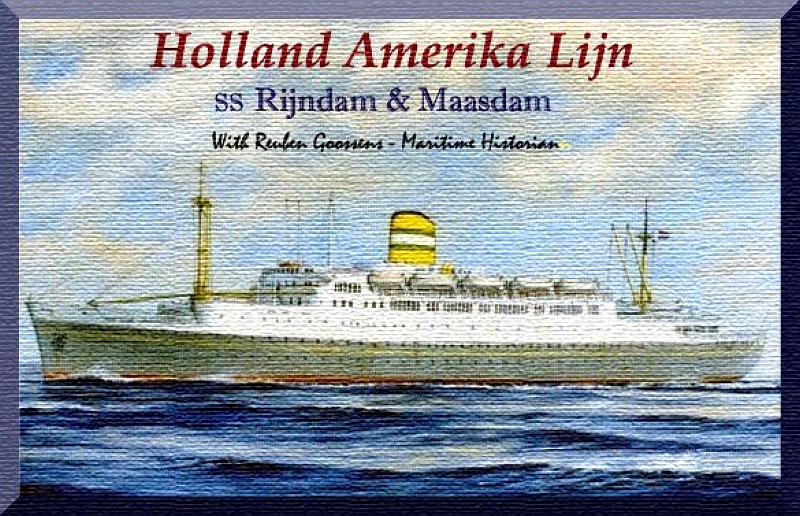
TSS Ryndam
II 1951 – 1972 / TSS Maasdam IV 1952 - 1968
Please Note: At this time, this feature
is incomplete and unedited.
Early 1949, NASM - Holland America Line (HAL),
ordered two freighters, the Dinteldyk and Diemerdyk. On December
17, 1949 Dinteldyk was laid down at Schiedam as Yard #733. Whilst
construction was underway, Holland America Line’s Director
Mr. Willem H. de Monchy decided to redesign both ships into
medium sized passenger liners. Dinteldyk was launched as the
Ryndam one year later, on December 19, 1950, whereas Maasdam was
launched on April 5, 1952.
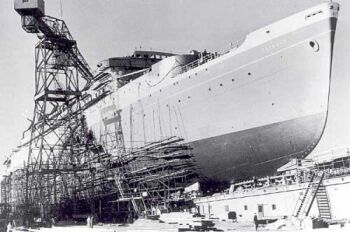
The Launching of the Ryndam
Holland America Line had announced that these
new sisters would introduce company’s new livery, with the
hull painted dove grey and a white superstructure. Her
fitting-out was well ahead of schedule and in May 1951 it was
decided to put forward her maiden voyage to July 16, instead of
August 16. After her trials in the English Channel, TSS Ryndam
was officially handed over to Holland America Line on July 10,
1951. Six days latter she departed Rotterdam bound for New York,
sailing via Le Havre and Southampton.

TSS Ryndam
arrives in New York City on her Maiden voyage
TSS Maasdam was handed over to HAL on August
10, 1952. Like her sister she was delivered early and departed
for her maiden voyage more than a month earlier than planned. She
departed on her maiden voyage from Rotterdam on August 11, to New
York, sailing via Le Havre and Southampton calling at Montreal on
the 20th. She continued to New York via the Cape Cod Canal; being
one of the largest ships to transit the waterway. Maasdam arrived
in New York on August 27th.
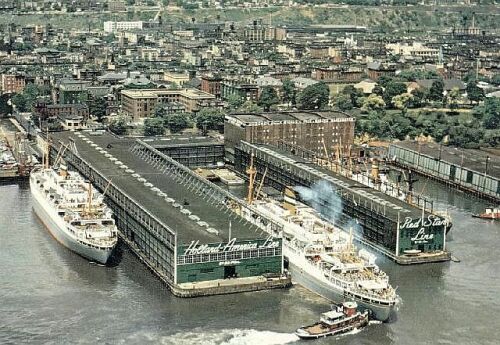
TSS Maasdam
and Ryndam at the Holland America Pier in New York
Designed as freighter’s the machinery
planned for them remained, these comprised of two cross-compound
General Electric steam turbines, which we built in 1945. They
developed 8,500shp double-reduction geared to a single screw.
Service speed was slow compared with other ships sailing at jus
16.5 knots, the crossing from Britain to New York took eight
days; however the daily fuel consumption was just 53 tons, making
these ships exceptionally economic to operate.
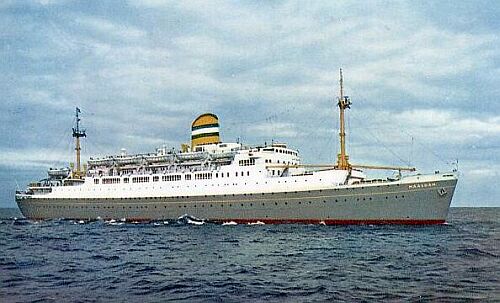
TSS Maasdam,
one of the successful “Economy Twins”
Although built with a two-class layout, TSS Ryndam
and Maasdam were revolutionary ships for their day, as they were
essentially built as Tourist class liners. Tourist Class
passengers basically had the run of the ship, except Boat Deck,
what was known as the “Exclusive First Class Penthouse
section” of the ship.
First Class
First Class offered fifteen twin bedded cabins,
some with an upper Pullman, accommodating a maximum 39
passengers. All cabins had had private facilities, and a large
window. Located forward on Boat Deck was the Main Lounge. On both
sides of the Lounge was a partial glass enclosed promenade deck,
followed by spacious open decks on both sides of the ship.
Located aft was the opulent Verandah Café. Two decks up, on Sun
Deck, just aft of the unique “slim-line” funnel was the
spacious First Class Sports Deck.
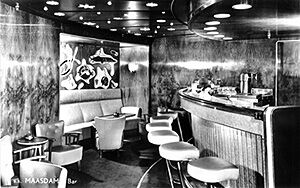
TSS Maasdam
– This First Class Bar was added in 1961
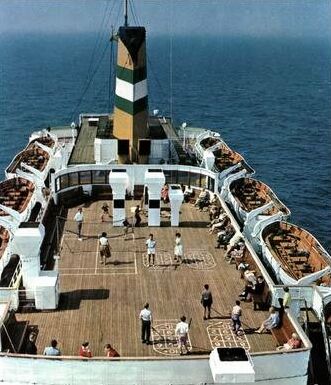
Sun Deck -
First Class Sports Deck – Note the slender aero-dynamic
funnel
Tourist Class
All Tourist Class public rooms were located on
Promenade Deck. The delightful Palm Court was located forward.
This large room was decorated in light woods, masses of bamboo
and greenery. Directly aft was the main lobby and stairwell,
which led to the Card Room and Library, and the delightful
American Bar. The Smoking Room located aft. The Dining Room was
located amidships on 'A' Deck. Although the decor was attractive,
the innovation of the décor was it gave this room a spacious
feel.
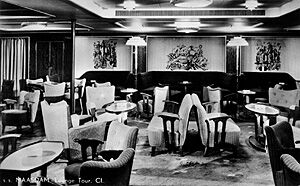
TSS Maasdam's
Main Lounge
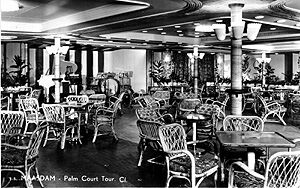
And her
friendly Palm Court
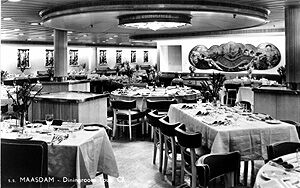
Maasdam’s
excellent Dinning Room
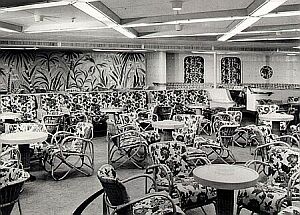
TSS Ryndam’s
had a rather more floral style Palm Court
854 Tourist passengers were accommodated in
smart single-berth, two-berth triples, and four-berth cabins.
Many British and American passengers commented, “Everything
is so Dutch; neat, pleasant and practical.” 893 passengers
were taken care of by 228 stewards.
The successful “Economy Twins,”
operated between Rotterdam, Le Havre, Southampton (with
occasional calls to Cobh), en route to New York, as well as
occasional cruises in the Caribbean. Over the first years they
managed 85% occupancy on Atlantic voyages, and an incredible 98%
on cruises.
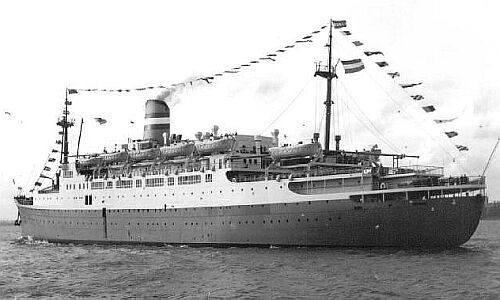
TSS Maasdam
seen bedecked with flags during a Cruise
Ryndam and Maasdam developed a 'Friendly Ship'
reputation, making them appealing to students, emigrants, and
cultural groups. First Class attracted the elite, who enjoyed
sitting high above Tourist Class, in their Penthouse style
accommodations. We may call this the “snob effect.” The
appeal of these ships was emulated by the 24,300 GRT, 1957 built
Statendam, which also carried a small number of First Class
passengers.
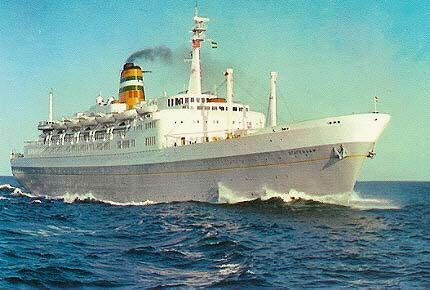
The grand TSS
Statendam
TSS Maasdam had a number of altercations with
other ships, such as, on December 10, 1952, just four months
after her maiden voyage, Maasdam collided with and sank the
268-ton German tanker Ellen, whilst sailing in fog in the canal
that links Rotterdam to Hook of Holland. Six of tanker's crew
were lost, although the Maasdam was undamaged. Two years later,
whilst sailing eastbound on October 3, 1954, she struck the
freighter Tofevo in thick fog off Rhode Island. Maasdam's bow was
damaged, and both ships returned to New York. In the mid-fifties
a ship hit the Holland America wharf, damaging Maasdam’s bow
above the waterline.
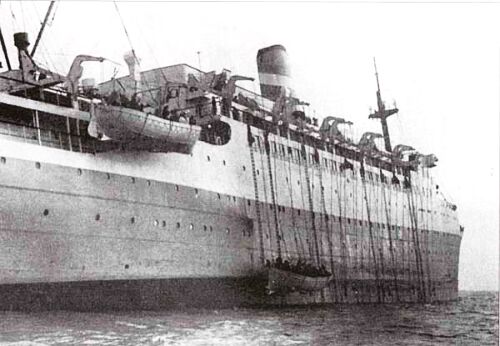
Here we see
one of Maasdam’s mishaps
One of the main problems with both ships was
the freighter hull design, which meant that in a little, or rough
weather, they would pitch and roll, causing some discomfort to
say the least. Thus, in 1955 the Maasdam was fitted with Denny
Brown stabilizer fins, with the Ryndam following one year later.
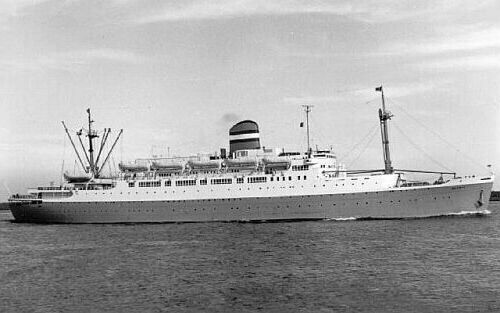
In 1961 both ships had a number of amidships
twenty four Tourist Class cabins on Main Deck rebuilt and were
fitted with private facilities, reducing Tourist capacity to 822
berths. In addition the First Class Lounge was extended, adding a
delightful Bar located in an alcove on the starboard side.
By 1964, passenger numbers declined, thus Holland
America embarked on a series of changes for 'The Economy Twins'.
At that time the Round the World service to Australia and New
Zealand, operated by the Dutch Mail ships (Royal Rotterdam Lloyd
– Nederland Line), Willem Ruys and Oranje was withdrawn. Holland
America decided to operate a one-class service during the
European winter months. The Ryndam was the first to undertake
this voyage, departing from Rotterdam on November 7, 1964,
sailing via Southampton, Suez, Fremantle, Melbourne, Sydney, Wellington,
returning to Rotterdam on January 30, 1965, having sailed via the
Pacific coast and the Panama Canal. This extended voyage visiting
many ports in both directions was met with some success, thus,
the next year, on October 20, 1965, Maasdam departed Rotterdam,
sailing via Southampton, Port Said, Colombo, Fremantle
–Melbourne, Sydney, Wellington, Papeete, Los Angeles,
Acapulco, Balboa, Cristobal, Kingston, New York, Cobh,
Southampton to Rotterdam.
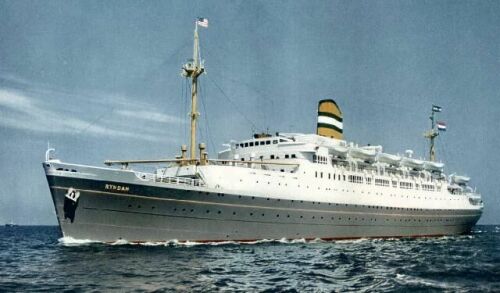
TSS Ryndam
and Maasdam were suitable small liners for the around the world
service
With the success of these voyages, Holland America
decided to refit the Ryndam at Norddeutschen Lloyd Werft in Bremerhaven,
arriving there on December 3, 1965, for a two month refit. A 280
seat cinema-theatre added on D Deck in what was originally the
forward hold, a launderette. Public rooms received some
refurbishments, including a new bar in the Lounge. On February 6,
1966, she departed Rotterdam on which sadly became her last world
voyage. However, Maasdam continued the service for another two
more years.
Europa-Canada Line:
Early 1966 Holland America decided to transfer
the Ryndam to their German flagged subsidiary, the
“Europa-Kanada Linie,” in order that she could operate
on the Canada service. However, she operated her last voyage to Montreal
for 1966 was on August 20.
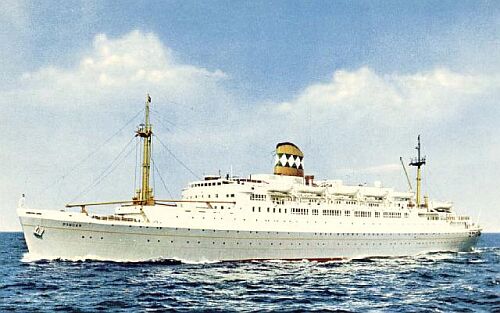
TSS Ryndam
showing her new Europa-Canada Line funnel
She was re-registered in Bremen and her yellow
funnel was given a green band with large white diamonds. Her new
role was to be a low cost student voyages. The crew was replaced
by the lower salaried German crew. TSS Ryndam departed on October
8, for her first student voyage from Bremerhaven to New York.
However, on October 20, she commenced her first
round-the-world Student “Campus” Cruise, as she had
been chartered by the “Chapman College” of Orange, California.
Whilst previously she was a two class
liners with a very small First Class section f the ship, now she
was operated as a one-class ship offering mostly buffet style,
self-service in the dining room. Between her extended 'floating
university' cruises, she also made Atlantic crossings for a
number of student organisations. The Maasdam was also transferred
to this service in October, 1966.
Ryndam’s career under the German flag was
short-lived as Holland America was not satisfied with the new
management and poor maintenance, considering there had been some
damage incurred to a boiler, as well as low profits.
On August 28, 1967 she was transferred yet
again to another affiliated company, the Dutch flag
“Trans-Ocean Steamship Company”. Like Europa-Canada,
Trans-Ocean specialised in student as well as migrant traffic,
with the three austere Dutch migrant ships, the SS Zuiderkruis,
Waterman and the Groote Beer.
She departed Bremerhaven on September 29, 1967,
arriving in New York on October 9. She now was given the
Trans-Ocean's official funnel livery of narrow red-white-blue
funnel bands and was again fully manned by Dutch officers and
crew. She did undertake another “Chapman College” world
campus cruise on October 11, 1967.
TSS Ryndam, renamed TSS Waterman:
On 24th May 1968 the TSS Rijndam still under
charter to “Trans-Ocean Steamship Company”, they
decided to rename her “Waterman.” She was then placed
on the Trans-Atlantic service commencing the next day, May 25,
and this continued until to October 10, 1968.
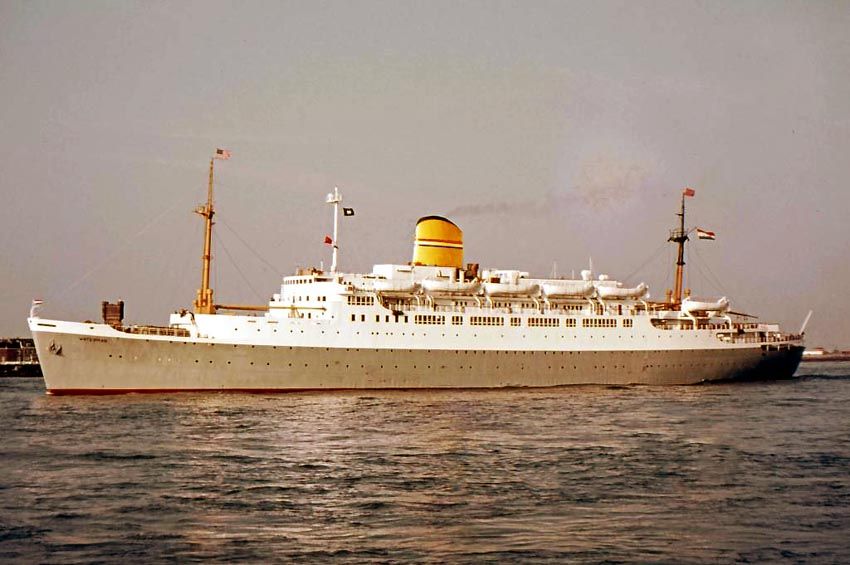
TSS
Waterman (ex Ryndam) is seen above with the Trans-Ocean funnel
livery
The TSS Waterman, revealing her new funnel
marking, departed New York on October 25 for the first of seven
voyages to Southampton and Rotterdam. Upon completion of the
charter, Holland America again took control of the Ryndam on
October 10, and she reverted to her original name and livery, but
she continued the student cruises, as there was such a great
demand for them in those days.
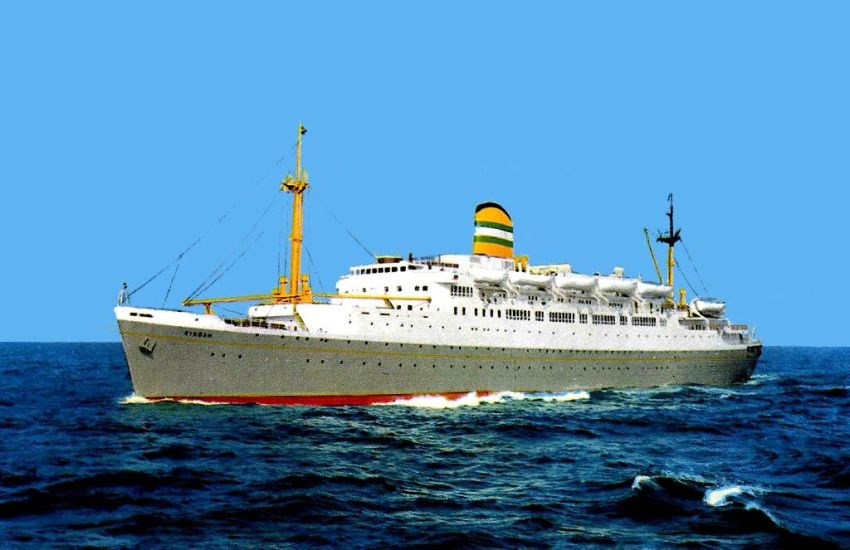
A Holland
America Line postcard of the TSS Ryndam
The next section will cover the TSS Ryndam, and
then the TSS Maasdam concluding days.
********************
TSS Atlas:
Finally in 1973, the Ryndam was sold to a
Panamanian subsidiary of a Greek shipping interest Epirotiki
Lines & Cruises, and she was radically rebuilt with her bow
line changed as well as many internal changes, and massive
alterations to her superstructure. This was done to give her a
ultra modern look for the day, what could be called a 1970's
design and was renamed SS Atlas.
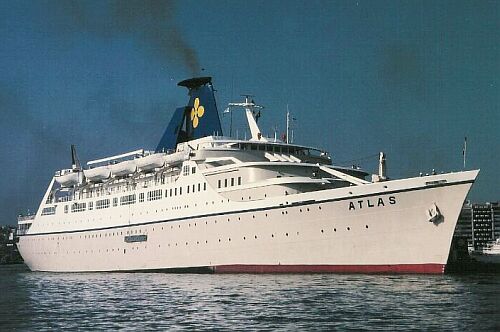
TSS Ryndam
is seen here after her radical rebuilding to become the SS Atlas
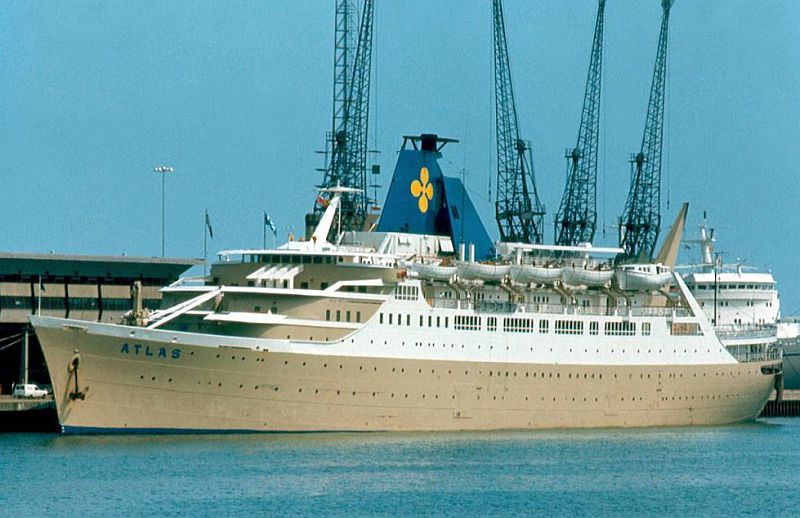
The Atlas
is seen here at Southampton in mid 1970s
TSS Pride of Mississippi:
However, in 1988 she was sold to Casino Company
and she commenced short cruises in the Gulf of Mexico under the
name Pride of Mississippi, but in 1991 was renamed once again as
the Pride of Galveston.
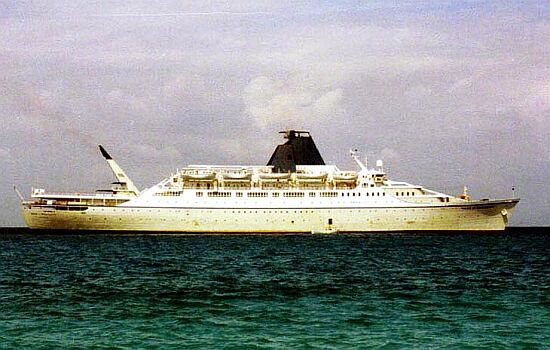
Casino Ship
SS Pride of Mississippi is seen here around 1989
In 1993, as the ship was no longer mechanically
seaworthy, it was decided to have her permanently berthed at Biloxi,
Mississippi and she was renamed - Copa Casino. But, the company
neglected badly so many ways for externally she looked terrible,
nothing line the beautiful ships she had been. Now it was just
Casino style glitz and glamour internally. In addition, they
continually added more and more structures atop of the ship,
making her an eyesore, and eventually the port authorities were
forced to make her owners to get rid of her. Her owners decided
that she would be unsalable to private investors and therefore it
was best to sell her to the breakers.
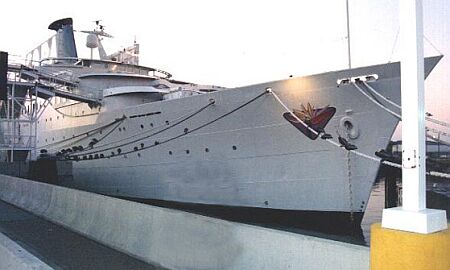
Copa Casino
at Biloxi, Mississippi
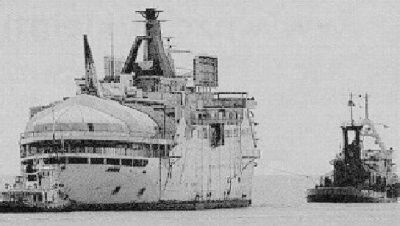
The tragic
looking Copa, ex TSS Ryndam seen under tow to Alang, or better
still, her watery grave
She was sold to Indian breakers at Alang in
2003. However, whilst under tow to Alang India she took on water
and sadly sunk. There were many at the time who said, and it was
stated in the news, “How convenient!” Personally
I would not like to comment, I only quoted what the news of the
day actually said!
Memories of the TSS Ryndam!
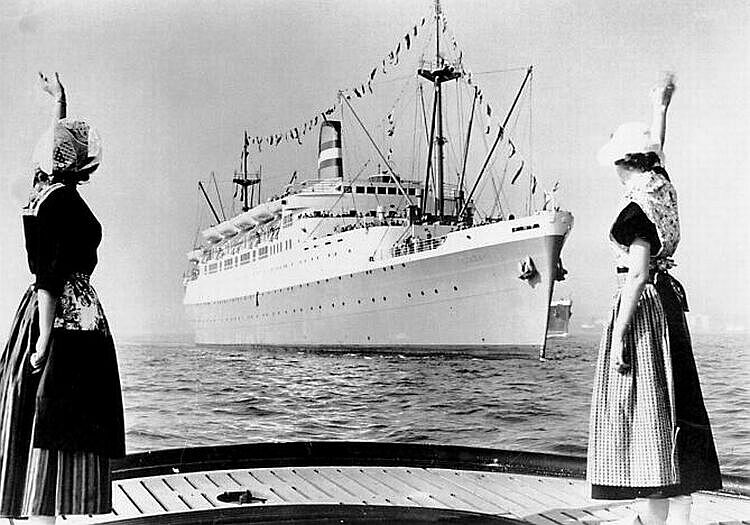
Holland
America Line promotional photograph of the TSS Ryndam
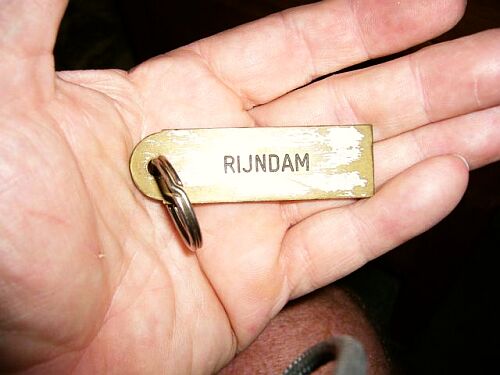
Above
and below: Cabin key – Main Deck Cabin 211
Provided by
Bibb Edwards USA
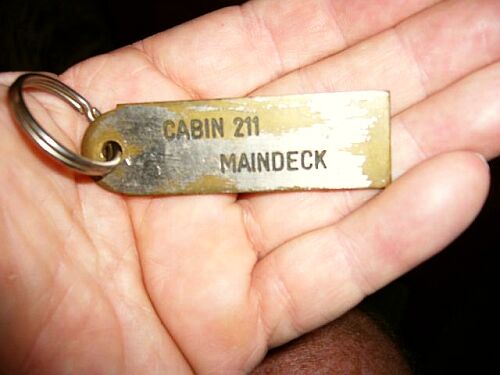
***********************************
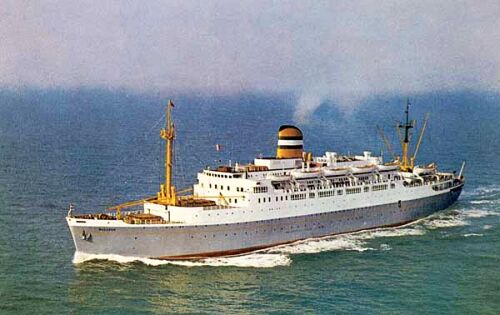
TSS Maasdam
TSS Maasdam’s Final Days:
Maasdam's final world voyage was from January 7
to April 3, 1968. Upon her return to Rotterdam she was placed on
the Canada service. On May 15 a shock announcement was made that
Maasdam had been sold to “Polish Ocean Lines,” and she
would be handed over at the completion of her Canada service. On
September 20 Maasdam departed Montreal on her last Atlantic
crossing under Holland America’s Dutch colours, and she was
paid-off at Rotterdam on September 29, 1968. Soon she
headed for Gdansk in Poland where she had a comprehensive refit
and headed into a new and a successful career as the Stefan Batory.
She proved to be a most successful Trans-Atlantic Liner and a
cruise ship. however in 1988 her owners decided to lay her up and
find other work for her. This would be in Gothenburg, Sweden
where she became a hostel for asylum seekers. She remained there
offering the best of accommodations from 1990 to 2000. In 2000,
with the hostel having closed there was no further use for this
fine old ship, the Stefan Batory, thus it was decided to sell her
to Turkish breaker and soon she was on the way to Aliaga where
she was duly broken up.
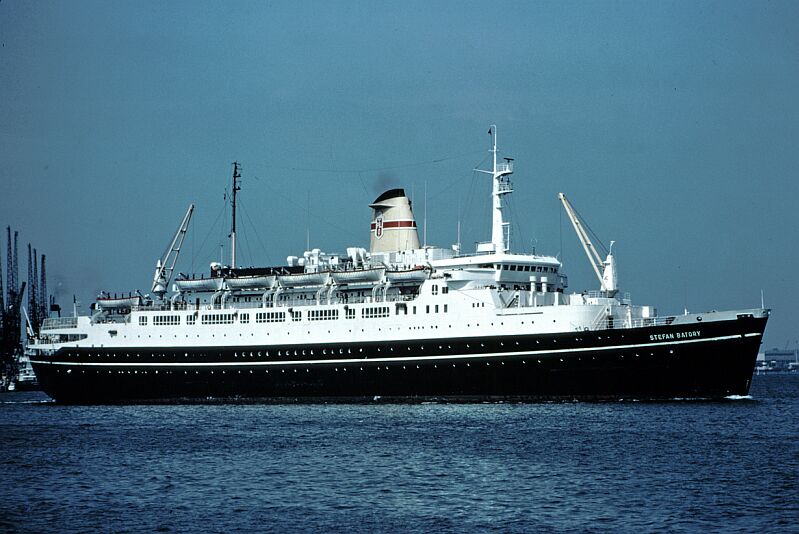
TSS Maasdam
seen here in her new guise as the Polish liner, SS Stefan Batory
************************
“Blue
Water Liners sailing to the distant shores.
I watched them come, I watched them go, and I watched them
die.”
****************************
Visit our ssMaritime
Main INDEX
Where
you will discover well over 750 classic liners!
Where
the ships of the past make history & the 1914 built MV Doulos
Story
Also
visit my
“Save The
Classic Liners Campaign”
Please Note: ssmaritime and associated
sites are 100% non-commercial and the author seeks no funding or
favours of any shape or form, never have and never will!
Photographs on ssmaritime and associate
pages are by the author or from the author’s private
collection. In addition there are some images that have been
provided by Shipping Companies and private photographers or
collectors. Credit is given to all contributors. However, there
are some photographs provided to me without details regarding the
photographer/owner concerned. I hereby invite if owners of these
images would be so kind to make them-selves known to me (my email
address may be found on www.ssmaritime.com only), in order that due
credit may be given.
This notice covers all pages, although,
and I have done my best to ensure that all photographs are duly
credited and that this notice is displaced on each page, that is,
when a page is updated!
ssMaritime
is owned & © Copyright by Reuben Goossens - All Rights
Reserved





























